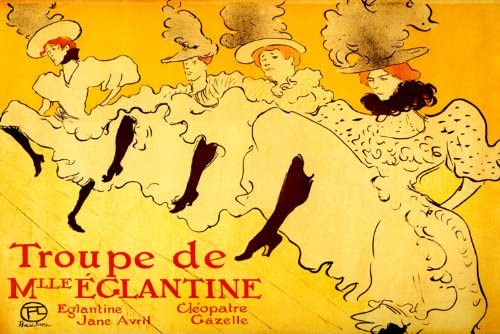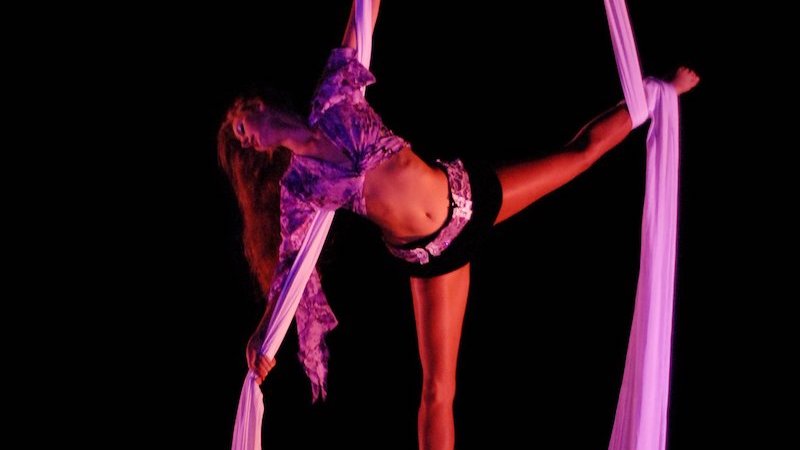I recently attended a fun day at a factory celebrating its 100th anniversary. Among the events at the fun day was a small circus featuring a variety of skilled acts. The ringmaster, an Australian called Steve, performed the world’s most difficult trick involving toothbrushes. Two Kenyan brothers did an extraordinary hat juggling act. But the most striking act was a young lady called Miss Freya, a master of the relatively new circus discipline of aerial silk.
Aerial silk
Aerial silk performers—usually, though not exclusively, female—dangle from fabric ‘ropes’ and perform acrobatics. It’s a skillful and dangerous art, made all the more impressive by occurring high up in a dark circus tent. Like the can-can, the key moments of an aerial silk routine—those which generate the strongest audience reaction—are the moments when the artist spreads their legs the widest. In aerial silk they slowly circle in the spotlight, revealing themselves to the audience.
Like the can-can, the key moments of an aerial silk routine—those which generate the strongest audience reaction—are the moments when the artist spreads their legs the widest.
A former aerial silk performer who read this blog emailed that her favourite pose was the splits. She added that some people felt uncomfortable with the splits. She felt only “the JOY in the pose.”
Aerial silk violates the social rule that public displays of the genitals are shameful. The shaming of sexuality is a key component of what I call the Patriarchal Operating System, the acquisitive, consumptive and destructive psychological model that’s crippling humanity and the planet.
Taboo
This prohibition dates from around 6,000 years ago when scattered societies, often goddess-worshipping and with a relatively equal division of power between genders, gave way to patriarchy and the rise of the earliest civilizations.
Steve Taylor, a psychology lecturer at Leeds Beckett University, writes in The Fall that “new levels of technology and civilisation, intense warfare, patriarchy, social inequality… the oppression of children, theistic religion… hostility to sex, to the body and to nature… all of these happened at the same time to the same peoples from the same area of central Asia and the Middle East.”
Ever since, displays of the human body—particularly its sexual parts—have been taboo; to this day public nudity is illegal in most of the world. (For a fuller explanation of this critical shift, please see A brief history of shame.)
Enforced public nudity
As a consequence, enforced public nudity has historically been used to shame wrongdoers, often for sexually related misdeeds such as adultery, or having sex across social barriers such as race, class or political lines.
This practice reached epidemic proportions during the European witch-hunting mania of the late medieval period. Supposed witches—often accused on the slightest of pretexts—were routinely stripped naked in public before being subjected to inhumane tortures and, often, death. The practice of stripping accused witches continues to this day in the remote highlands of Papua New Guinea.
The practice of publicly enforced nudity has three objectives:
- Punishing supposed transgressors
- Warning others to behave along socially accepted lines
- Providing a socially legitimate mechanism for viewing that which is taboo: the body
Because viewing the genitals of others is taboo—giving rise to feelings of shame in the viewer—this mechanism acquires a ritualistic aspect. So-called ‘witch trials’ are an example of rituals enacted to allow public exposure of the genitals in a socially sanctioned manner.
The ritual gives form to the taboo activity by delineating the conditions under which it can take place. It provides an environment in which those who uphold public decency can ‘cleanse’ society without themselves being infected by the perceived impurity of that which is taboo.
The can-can
In recent centuries, the growing recognition of personal rights saw a decline in publicly enforced nudity. However, the desire to see that which is taboo remained.
This led to the rise of alternative means of displaying the taboo. During the 1840’s in France the can-can became popular. In this dance the dancers raise their legs or bend over at the waist to display their thinly veiled sexual parts. These poses were very similar to those now seen in aerial silk:

The darkened cabarets and dance halls of Paris thus became the ritual space where audiences could legitimately view—or almost view—the taboo.
Aerial silk transported the can-can from the two-dimensional world of the stage to the three-dimensional world of the big top. It’s reputed to have originated in a French circus school in the late 1950s. Aerial silk was popularized by Isabelle Vaudelle and Isabelle Chasse of the Cirque du Soleil in the 1990s. It’s now a widely performed circus act.
Trends
While it may seem ridiculous—or even voyeuristic—to associate aerial silk with public displays of the genitals, the discipline should be considered in the light of other trends. The history of civilization is nothing other than the history of male domination over displays of the female body and women’s long fight to de-objectify and de-sexualise their bodies, reclaiming the right to display them as they choose.
Events like ‘slut walks’ and the #freethenipple and #underboob Twitter campaigns show this trend accelerating in recent years. The last remaining step is public displays of the genitals. That aerial silk is part of this trend—whether consciously or unconsciously—is clear. Some artists wear skin-coloured bodysuits to increase the impression that the performer is nude.
Modern society stands on the brink of breaking the taboo on public displays of the genitals. It can only be a matter of time before that barrier is broken. A socially accepted means of displaying the genitals will inevitably emerge. Like the can-can and aerial silk, it will probably come via the arts. The slow journey to repeal 6,000 years of sexual repression inexorably marches on.

